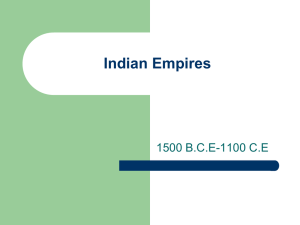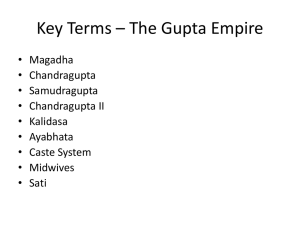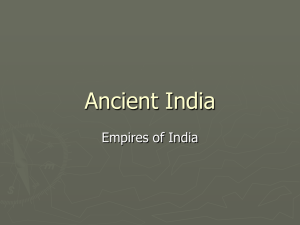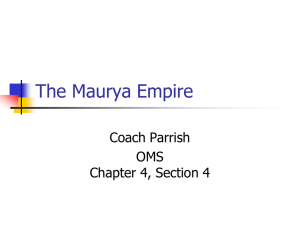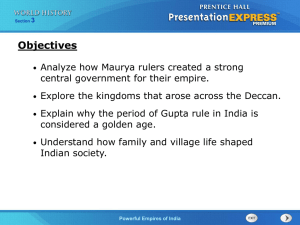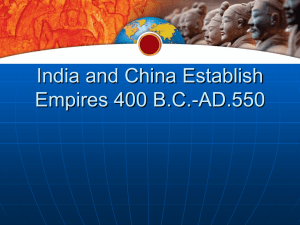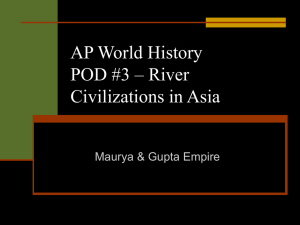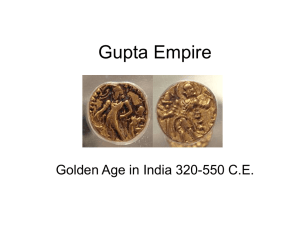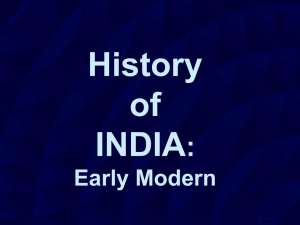Powerful Empires of India
advertisement
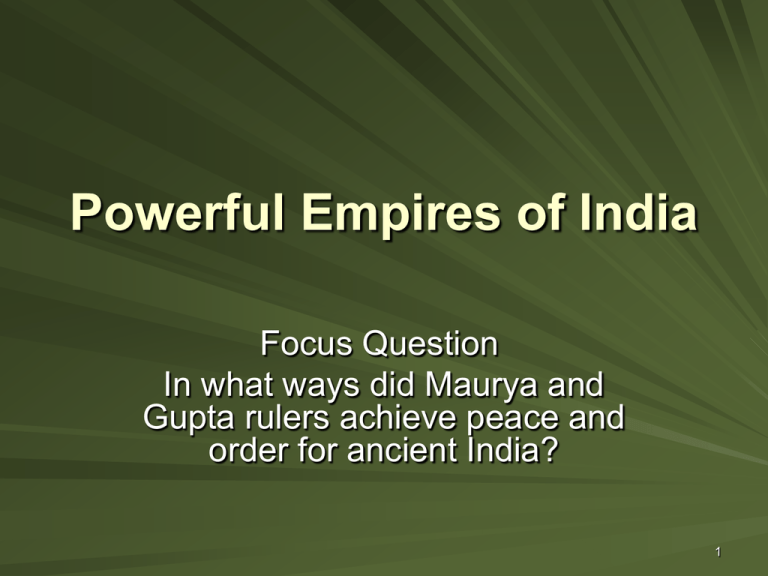
Powerful Empires of India Focus Question In what ways did Maurya and Gupta rulers achieve peace and order for ancient India? 1 Chandragupta Forges an Empire A man named Chandragupta first gained power in the Ganges valley. He then conquered northern India. His son and grandson later pushed south, adding much of the Deccan to their empire. From 321 B.C. to 185 B.C., the Maurya dynasty ruled over a vast, united empire. 2 Chandragupta maintained order through a well-organized bureaucracy. Royal officials supervised the building of roads and harbors to benefit trade. Other officials collected taxes and managed state-owned factories and shipyards. People sought justice in royal courts. 3 Chandragupta’s rule was effective but harsh. A brutal secret police force reported on corruption, crime, and dissent—that is, ideas that opposed those of the government. Fearful of his many enemies, Chandragupta had specially trained women warriors guard 4 his palace. Asoka Rules by Moral Example The most honored Maurya emperor was Chandragupta’s grandson, Asoka (uh soh kuh). A few years after becoming emperor in 268 B.C., Asoka fought a long, bloody war to conquer the Deccan region of Kalinga. Then, horrified at the slaughter— more than 100,000 people are said to have died—Asoka turned his back on further conquests. He converted to Buddhism, rejected violence, and resolved to rule by moral example. 5 True to the Buddhist principle of respect for all life, Asoka stopped eating most meats and limited Hindu animal sacrifices. He sent missionaries, or people sent on a religious mission, to spread Buddhism across India and to Sri Lanka. By doing so, he paved the way for the spread of Buddhism throughout Asia. Although Asoka promoted Buddhism, he also preached tolerance for6 other religions. Asoka had stone pillars set up across India, offering moral advice and promising a just government. Asoka’s rule brought peace and prosperity and helped unite the diverse peoples within his empire. He built hospitals and Buddhist shrines. To aid transportation, he built roads and rest houses 7 for travelers Watch Asoka’s Elephant Warriors on Discovery Learning School 8 Division and Disunity Set In After Asoka’s death, Maurya power declined. By 185 B.C., the unity of the Maurya empire was shattered as rival princes again battled for power across the Gangetic Plain. 9 In fact, during its long history, India has seldom remained united for long. In ancient times, as today, the subcontinent was home to many peoples. Although the Aryan north shared a common civilization, fierce local rivalries kept it divided. Meanwhile, distance and cultural differences separated the peoples of the north and the peoples of the Deccan in the south 10 Adding to the turmoil, foreigners frequently pushed through mountain passes into northern India. The divided northern kingdoms often proved incapable of resisting these conquerors. 11 Kingdoms Arise Across the Deccan Like the Gangetic Plain, the Deccan was divided into many kingdoms after the decline of Maurya power. Each kingdom had its own capital with magnificent temples and bustling workshops. The peoples of the Deccan were Dravidians with very different languages and traditions from the peoples of the Aryan north 12 Over the centuries, Hindu and Buddhist traditions and Sanskrit writings drifted south and blended with local cultures. Deccan rulers generally tolerated all religions as well as the many foreigners who settled in their busy ports. 13 In the Tamil kingdoms, which occupied much of the southernmost part of India, trade was important. Tamil rulers improved harbors to support overseas trade. Tamil merchants sent spices, fine textiles, and other luxuries westward to eager buyers in the Roman empire. And as the Roman empire declined, Tamil trade with China increased 14 How do you think trade helped link the separate kingdoms of the Deccan? 15 The Guptas Bring About a Golden Age Although many kingdoms flourished in the Deccan, the most powerful Indian states rose to its north. About 500 years after the Mauryas, the Gupta dynasty again united much of India. Gupta emperors organized a strong central government that promoted peace and prosperity. Under the Guptas, who ruled from A.D. 320 to about 540, India enjoyed a golden age, or period of great cultural achievement 16 Peace and Prosperity Abound Gupta rule was probably looser than that of the Mauryas. Much power was left in the hands of individual villages and city governments elected by merchants and artisans. 17 Trade and farming flourished across the Gupta empire. Farmers harvested crops of wheat, rice, and sugar cane. In cities, artisans produced cotton cloth, pottery, and metalware for local markets and for export to East Africa, the Middle East, and Southeast Asia. The prosperity of Gupta India contributed to a flowering in the arts and learning. 18 Indians Make Advances in Learning Under Gupta rule, students were educated in religious schools. However, in Hindu and Buddhist centers, learning was not limited to religion and philosophy. The large Buddhist monasteryuniversity at Nalanda, which attracted students from many parts of Asia, taught mathematics, 19 medicine, physics, languages, literature, and other subjects. Indian advances in mathematics had a wide impact on the rest of the world. Gupta mathematicians devised the system of writing numbers that we use today. (However, these numerals are now called “Arabic” numerals because Arabs carried them from India to the Middle East and Europe.) Indian mathematicians also originated the concept of zero and developed the decimal system of numbers based on ten digits, which we still use today. 20 By Gupta times, Indian physicians were using herbs and other remedies to treat illness. Surgeons were skilled in setting bones and in simple surgery to repair injuries. It seems that doctors also began vaccinating people against smallpox about 1,000 years before this practice was used in Europe. 21 Expanding India’s Literature During Gupta times, many fine writers added to the rich heritage of Indian literature. They collected and recorded fables and folk tales in the Sanskrit language. In time, Indian fables were carried west to Persia, Egypt, and Greece. 22 The greatest Gupta poet and playwright was Kalidasa. His most famous play, Shakuntala (shahk oon tah luh), tells the story of a king who marries the lovely orphan Shakuntala. Under an evil spell, the king forgets his bride. After many plot twists, he finally recovers his memory and is reunited with her. 23 The Gupta Empire Declines Eventually, Gupta India declined under the pressure of weak rulers, civil war, and foreign invaders. From central Asia came the White Huns, a nomadic people who overran the weakened Gupta empire, destroying its cities and trade. Once again, India split into many kingdoms. It would see no other great empire like those of the Mauryas or Guptas for almost 1,000 years 24 How did religion influence learning and the arts in Gupta India? 25 Family and Village Life Shape Indian Society Most Indians knew nothing of the dazzling courts of the Mauryas or Guptas. The vast majority were peasants who lived in the villages that dotted the Indian landscape. In Indian society, everyday life revolved around the rules and duties associated with caste, family, and village. 26 Joint Family Structure The ideal family was a joint family, in which parents, children, and their offspring shared a common dwelling. Indian families were patriarchal—the father or oldest male in a family headed the household. Adult sons continued to live with their parents even after they married and had children. (A daughter would go to live with her husband and his family.) 27 Often only the wealthy could afford such large households. Still, even when they did not share the same house, close ties linked brothers, uncles, cousins, and nephews 28 A father was thought to have wisdom and experience, and he enjoyed great authority. Even so, his power was limited by sacred laws and tradition. Usually, he made decisions after consulting his wife and other family members. Property belonged to the whole family. 29 The Family Performs Certain Duties The family performed the essential function of training children in the traditions and duties of their castes. Thus family interests came before individual wishes. Children worked with older relatives in the fields or at a family trade. While still young, a daughter learned that as a wife she would be expected to serve and obey her husband and his family 30 A son learned the rituals to honor the family’s ancestors. Such rites linked the living and the dead, deepening family bonds across the generations. 31 For parents, an important duty was arranging good marriages for their children, based on caste and family interests. Marriage customs varied. In northern India, for example, a bride’s family commonly provided a dowry, or payment to the bridegroom, and financed the costly wedding festivities. After marriage, the daughter left her home and became part of her husband’s family. 32 Role of Women Changes Over Time In early Aryan society, women seem to have enjoyed a higher status than in later times. Aryan women even composed a few Vedic hymns. However, attitudes and customs affecting women varied across India and changed over time 33 By late Gupta times, upper-class women were increasingly restricted to the home. When they went outside the home, they were supposed to cover themselves from head to foot. Lower-class women, however, labored in the fields or worked at spinning and weaving. 34 Women were thought to have shakti, a creative energy that men lacked. In marriage, a woman’s shakti helped to make the husband complete. Still, shakti might also be a destructive force. A husband’s duty was to channel his wife’s energy in the proper direction. Women had few rights within the family and society. Their primary duties were to marry and raise children. 35 For a woman, rebirth into a higher existence was gained through devotion to her husband. Often, a widow was expected to join her dead husband on his funeral fire. In this way, a widow became a sati, or “virtuous woman.” Some widows accepted this painful death as a noble duty that wiped out their own and their husbands’ sins. Other women bitterly resisted the custom. 36 Typical Village Structure Each village included people of different castes who performed the necessary tasks of daily life. It ran its own affairs based on caste rules and traditions and faced little outside interference as long as it paid its share of taxes. A village headman and council made decisions. The council included the most respected people of the village. In early times, women served on the council 37 As Hindu law began to place greater restrictions on women, they were later excluded. The headman and council organized villagers to cooperate on vital local projects such as building irrigation systems and larger regional projects like building roads and temples. 38 Agriculture and Trade Shape Life In most of India, farming depended on the rains brought by the summer monsoons. Too much or too little rain meant famine. Landlords owned much of the land. Farmers who worked the land had to give the owner part of the harvest. Often, what remained was hardly enough to feed the farmers and 39 their families Describe the structure of a typical Indian family. 40
